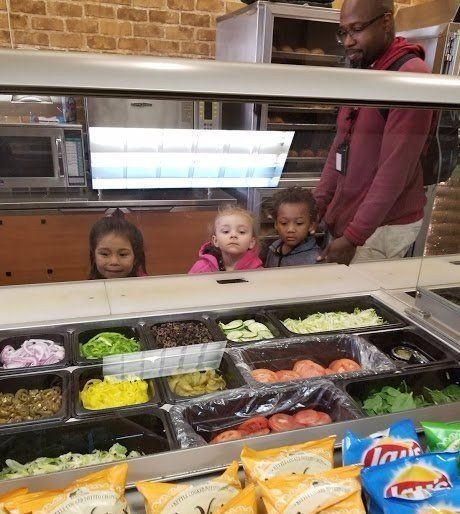"The Sandwich Shop" 11.9.17
by Ms. Lopez, Early Learning School Room 3A
At the beginning of each school year, all of the classes in Imagine Nation's Early Learning School begin their curriculum with Cornerstones. During Cornerstones, children explore the different centers of the classroom. In Room 3A, children showed a strong interest in the kitchen, a dramatic play center.
Children in our room made meals with their peers by pretending to cook pretend food on the stove, stacking sandwiches 3-inches high, or stirring ingredients in a pot. This opened a dialog about favorite foods and the importance of balanced, healthy meals. We discussed healthy choices and decided to pursue the Sandwich Shop as our first topic study of the year!
We set up a sandwich shop in the dramatic play center and the children are enjoying taking orders, making sandwiches, and finishing transactions at the register with play money.
Earlier this week, we went on a field trip to Subway! The students learned how the bread is made and how ingredients are prepped. Each child even got to order their own 6-inch sub for lunch! We used the opportunity to learn not just about commerce, but where food comes from and about good nutrition is with the use of MyPlate guidelines.


“Be Kind, Be Safe, Be Responsible” 10.12.17
by Sara Castle, Imagine Nation Assistant Director
These are the 3 universal rules we follow at Imagine Nation in our classrooms and in our studios. We encourage our children to be kind to others by lending a helping hand, using caring words, helping a teacher, or mentoring a younger child. We can be safe in the classroom and outside by using equipment appropriately, staying with the group, and using walking feet in the hallway. And being responsible means taking care of classroom materials, picking up after ourselves, and following the school and community rules. If everyone works together to follow these three rules, our community can be a happy, healthy, and fun place to be!
As adults, we must teach our children to follow these rules and expectations, but also follow them ourselves. As adults there are laws we must follow to protect our children and ourselves as well. Occasionally, these laws change and develop due to new research or information that is discovered. Over the past few years, there has been much research and development in the area of car seat safety.
Because of this, new car seat safety laws are going into effect as of October 1, 2017. These laws include the following:
• Infants must remain rear-facing until they are a minimum of both 2 year and 30 pounds.
• Toddlers must be in a forward facing car seat with 5 point harness until 5 years and 40 pounds.
• Children should ride in a booster until they reach 8 years old AND 60 pounds (they must meet both requirements). Children who ride in a booster seat must use a lap and shoulder belt.
• Children, tweens and teens must be in a seat belt whenever they ride in a vehicle.
Further Recommended: Children should ride in the back seat until they are 13 years old. All people and objects should be properly restrained whenever they are in a vehicle.
More details about these new child passenger safety laws can be found at http://www.ctsafekids.org/child-passenger-safety/.
By working together in our Imagine Nation community, we can help ensure that our children are happy, healthy, and safe while they learn.
Saying Goodbye at Child Care 9.14.17
Saying goodbye can be stressful time for little ones, since it is normal and healthy for young children to have a strong attachment to their parents. Young children's attachments and their ability to separate from their parents varies by age.
Children from birth to 12 months old are closely attached to their parents and dependent upon them for almost everything. They recognize that mom and dad are special people and prefer their company over other adults. Fear of strangers develops between seven and nine months. Separation from parents, such as going to child care, is difficult at this age because children are afraid their parents will not return.
Children from 1 to 3 years old are more independent. They enjoy playing and exploring on their own, but may stop what they are doing to be sure mom or dad is close by. At this age, children may feel comfortable with other familiar adults, but will be concerned about their parents leaving them.
Children from 3 to 5 years old can do more things for themselves. They enjoy playing on their own and with friends. Separations from their parents are easier at this age because they understand mom and dad still exist, even if they are not in the same room.
Preparing You Child for School/Child Care
• Visit the school or center ahead of time to meet the teachers or child care provider.
• Tell your toddler or preschooler what will happen at the school/child care center.
• Read stories to your child about going to school/child care.
• If possible, let your child stay at the school/child care center for short periods of time to get used to it.
• Give the teacher information to help her make your child feel at home.
Saying Good-Bye at School/Child Care
Infants and Toddlers (birth to 3 years)
• Establish "getting ready" routines, such as letting your child help you pack his bag or pick out clothing to wear.
• As you place your child's things in the cubby at school/child care, explain what you are doing.
• While holding your infant, let her look around. Walk around with your baby and tell her what is happening.
• Tell your child you are leaving, where you will be and when you will be back. Do not sneak out.
• Give hugs and kisses, and let the teacher take her.
• Once you have said good-bye, leave quickly.
• If allowed, give your child "security objects" from home (such as a blanket or a favorite toy).
• Hang family pictures in your child's cubby.
Preschoolers (3 to 5 years)
• Develop "getting ready" routines, such as having your child choose his own clothes for the day.
• Encourage your child to participate in ongoing activities and play with friends.
• Tell your child you are leaving, where you will be, and when you will be back.
• Let your child participate in the good-bye routine by making up special good-bye sayings, such as "See ya later, alligator."
• When you say good-bye, let your child decide if she wants a hug or kiss.
• Once you have said good-bye, leave quickly.
The information was developed by The Family Conservancy
from a variety of professional resources. This is not a standardized measurement tool.


